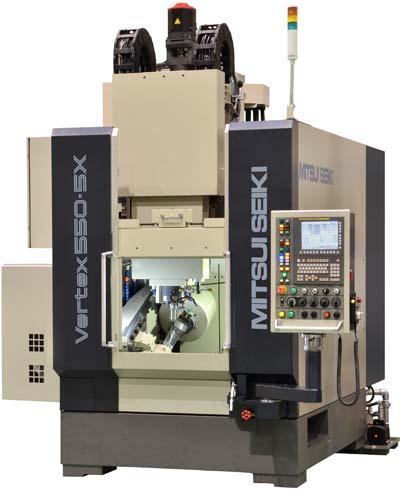
Mitsui Seiki USA Inc. has developed a specially-designed, 5-axis CNC vertical machining center for the production of turbine blades from forgings, castings, bar stock, or solid billets of titanium and stainless steel. According to the company, several customers provided design criteria, including a reasonable capital cost per part, small machine footprint, the ability to rough and finish parts in competitive cycle times, and improved part accuracy and surface finish.
"In other words," says Tom Dolan, VP of Mitsui Seiki, "the total machining center package had to be smaller, faster, more accurate than what they had been using, all at an affordable price."
After about 18 months in development, the new Vertex 550-5XB machine is the result. Key specifications include a footprint of approximately 65 sq. ft., an X, Y, Z working envelope of 550mm x 600mm x 500mm, and rapid traverse rates in all linear axes of 48m/min. A and B axes are represented in a rotating/tilting table. A-axis tilts from +45 to 90 degree angles, and the B-axis features infinite positioning points. The engineering of the rotary axes offers a new, non-traditional approach, which Dolan says enhances manual and automatic load/unload operations, such as the integration of a robot and cellular manufacturing capability. Further, Mitsui Seiki has incorporated its proven spindle configuration in the new Vertex 550-5XB, ideally suited to cut hard titanium and stainless steel grades. It also is directed by the latest and most advanced Fanuc control system.
Mitsui Seiki's tradition is to build rigid and ultra precise metal cutting and grinding machines. The Vertex 550-5XB's geometric accuracy is carefully monitored in the tightest temperature-controlled factory environment in the world. The machine features a cast bed which provides an ultra rigid machine structure. A unique "box in a box" design provides superior rigidity and stiffness that typically is not available in a machine of this size. All guide way mounting surfaces are hand-scraped, achieving very high volumetric accuracies, which would be impossible to achieve on surfaces that are simply machined and/or ground. This engineering and construction concept, coupled with a newly designed machine, provides users with competitive advantages over traditional, similar purpose machines.
Contact Details
Related Glossary Terms
- computer numerical control ( CNC)
computer numerical control ( CNC)
Microprocessor-based controller dedicated to a machine tool that permits the creation or modification of parts. Programmed numerical control activates the machine’s servos and spindle drives and controls the various machining operations. See DNC, direct numerical control; NC, numerical control.
- grinding
grinding
Machining operation in which material is removed from the workpiece by a powered abrasive wheel, stone, belt, paste, sheet, compound, slurry, etc. Takes various forms: surface grinding (creates flat and/or squared surfaces); cylindrical grinding (for external cylindrical and tapered shapes, fillets, undercuts, etc.); centerless grinding; chamfering; thread and form grinding; tool and cutter grinding; offhand grinding; lapping and polishing (grinding with extremely fine grits to create ultrasmooth surfaces); honing; and disc grinding.
- machining center
machining center
CNC machine tool capable of drilling, reaming, tapping, milling and boring. Normally comes with an automatic toolchanger. See automatic toolchanger.
- rapid traverse
rapid traverse
Movement on a CNC mill or lathe that is from point to point at full speed but, usually, without linear interpolation.
- stiffness
stiffness
1. Ability of a material or part to resist elastic deflection. 2. The rate of stress with respect to strain; the greater the stress required to produce a given strain, the stiffer the material is said to be. See dynamic stiffness; static stiffness.
